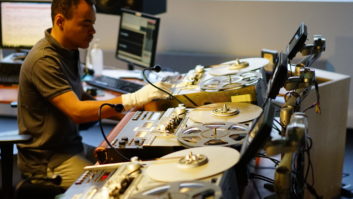I was asked to talk a little about what I am seeing in the market from a technical perspective right now and I’ve challenged myself to do so without using the phrases ‘New normal’ or ‘In these challenging times’. Wish me luck.
As the UK went into lockdown we certainly saw immediate business as additional cameras, encoders and streaming tools were purchased to ensure the ’show would go on’ but as things have settled down and people have been able to take a breath I’ve noticed a fundamental shift in conversations with our customers.
Firstly, is ‘good enough’ good enough? As an industry we’ve always prided ourselves on maintaining extremely high technical standards. Quality is paramount in broadcast and will always be important but the rush to deploy services recently and the specific issues in having to do so in places like people’s homes has meant that traditional methods of signal distribution were simply not possible. Initially this has meant using publicly available systems such as Skype or Zoom, which are easy to roll out but are not always consistent when the platforms are stressed. Fundamentally though they do work and, with the right tools, can produce acceptable outputs we can bring into the broadcast chain. Importantly the viewers were ok with it. At times of crisis people at home want to see familiar faces to feel comforted and entertained and trusted faces to be informed. Web conferencing has helped achieve that in places a crew or a truck just wouldn’t work.
Secondly, it’s a two-way street. Up until now we’ve been in the position of always getting a signal back to the production facility or broadcaster because that is where the systems, tools and people are. Very quickly we started working with customers on how to get signals back and forth from the facility to people’s homes. Remoting transmission multi-viewers and control surfaces was an early requirement with very specific requirements, particularly keeping latency down whilst maintaining a quality suitable for spotting issues. Again, a similar solution is required to get the return feed of a channel output back to on-screen talent for cues and monitoring where low-latency is crucial. The question was can we do this using the public internet? Using SRT technology the answer was ‘yes’. Supported by many vendors the SRT protocol enables latency in the few hundreds of milliseconds that’s firewall-friendly but robust enough to run over the public internet with end-to-end encryption.
Finally, to the Cloud. There has been a slow move to the Cloud for live work in recent times but recent conversations and trials have exploded around Cloud workflows. This can be using the Cloud to provide infrastructure and signal switching or to deploy full remote production tools and channels. Rolling out a system with little notice and infrastructure as possible fits firmly in the Cloud’s happy place. Technologies like SRT and NDI provide the links with tools that can be deployed and monitored from anywhere and billed on an ad-hoc basis – perfect for where we are today.
In terms of what I have seen from customers and these conversations is that the Covid crisis has driven innovation and pushed the limits of what various technologies can do. The speed of lockdown and the requirements forced on to customers has driven people to move away from their technical comfort zones and try new things. Things that would never have been attempted before are being tested and pushed to their limits to see what can be done. Engineers are being given license to be creative and to think the unthinkable, this is an Apollo 13 moment and some of the solutions being discovered will fundamentally change the way people work in the future.
OB’s and sport have been moving toward remote production for some time, whether for cost, environmental reasons or to give their staff a better quality of life. One thing for certain is that transition will be hugely accelerated now. Technology is showing has that we can work from home, we can do things without getting on a plane, we can do things without driving 300 miles. True you can’t remote everything, nothing replaces being there, social contact is hugely important and there are some things, like cameras, that just have to be on-site.
As we come out of lockdown we will never be the same. We have to consider what the changes forced on us have delivered, both good and bad. We will have to design systems with more flexibility in them from the core out, Covid has happened once and it could happen again. Good enough is sometimes good enough and the public internet and Cloud open up huge opportunities to do these things differently.
Crucially, in working from home we’ve discovered what’s important, how it feels not to commute or travel, what it’s like sitting down for dinner every night with the family. Many of us will look to make changes to our work lives moving forward and take something positive away from this terrible situation.
Finally, keeping quality content on-air has played a huge part in keeping people at home entertained, educated and informed. You often hear industry people joke and say ‘it’s only telly’ but right now as an industry we should be proud what we’ve achieved.







